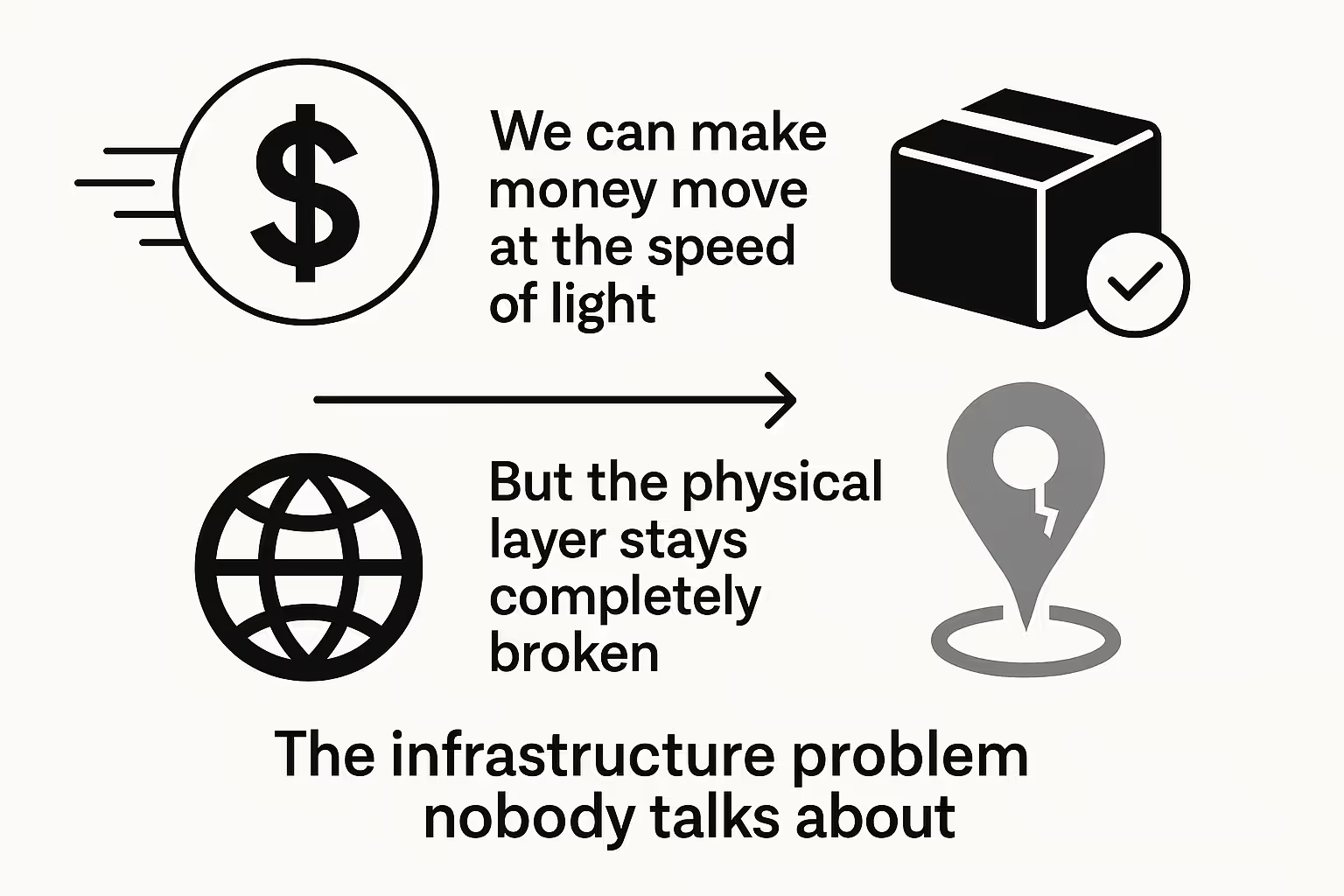
Solving Half the Equation: Why Payment Innovation Fails Without Addressing. We can make money move at the speed of light. We can send payments instantly across continents for pennies.
We can make money move at the speed of light. We can send payments instantly across continents for pennies.
But a girl in Nairobi still can't order a anything from Amazon without creating a fake address in the US, routing it through three intermediaries, and picking it up at some shady warehouse in an industrial area.
This is the infrastructure problem nobody talks about. We're racing to perfect digital payments while the physical layer stays completely broken.
Money serves to purchase goods. When goods become inaccessible, even flawless payment systems lose their purpose.
Yet we treat payment systems and addressing systems like separate problems. They're not.
Over 60% of Africa's urban population lives in informal settlements without proper addresses. Meanwhile, cross-border payments cost African businesses $5 billion annually in unnecessary fees.
Each barrier reinforces the other. No address means no e-commerce participation. No e-commerce means no volume. No volume means no infrastructure investment.
Everything is downstream of addressing.
The first mile and mid-mile logistics across Africa work fine. The breakdown happens at the last mile because we can't locate people.
Picture the current workaround. Someone creates a fake overseas address, pays international shipping rates, waits for consolidation services, then travels to industrial warehouses for pickup or for local deliveries she has to make herself available and be ready to give instructions on which corner the rider should be so they can meet-up to receive her package.
It's like putting duct tape on a broken pipe. Born out of necessity, but we can do better now.
E-commerce shouldn't require people to be available in person. If it does, it's broken.
The only thing worth waiting around for is food delivery. Everything else should drop at a secure location for convenient pickup.
Stablecoins solve the payment friction. Digital addresses solve the delivery problem.
Together, they create something exponentially more powerful than either alone.
Stablecoins enable instant, low-cost transactions across borders. They can cut payment costs by up to 80% compared to traditional methods. But if goods can't move, fast money becomes meaningless.
Digital addressing changes the economics completely. When logistics companies have reliable delivery points, their margins improve. Their volumes increase. Their profitability jumps.
When you have volume, you can build efficient systems around it. Without volume, delivery stays expensive and unreliable.
When merchants gain access to both stablecoins and digital addresses, their potential customer base expands by orders of magnitude.
They're no longer limited by geography or broken payment rails. They can sell to anyone, anywhere, with reliable delivery.
This unlocks populations that have been completely forgotten by global commerce. People who want to participate but can't because the infrastructure doesn't exist.
The emerging world has massive demand. What it lacks is infrastructure that works.
We're building that infrastructure now.
Here's what makes this different from every other addressing or payment system.
When you create a digital address through blockchain infrastructure, you own it completely. You get public and private keys. The address belongs to you, not to any company.
Building for people should not mean that you own them.
This is infrastructure built on public rails, not private databases that can be suspended or deleted.
People keep what is theirs. They control their own addressing and payment systems.
Traditional gatekeepers face a choice. Banks, payment processors, logistics monopolies. Adapt or become irrelevant.
We're already seeing banks scramble to integrate stablecoin infrastructure. The same will happen with logistics companies as digital addressing scales.
The old world will have to adapt to the new. Supply chain management on blockchain is a natural fit for this infrastructure.
But the future belongs to systems that give users sovereignty, not dependence.
We're not building isolated solutions. We're building the rails that enable everything else.
When payment and delivery infrastructure work seamlessly together, e-commerce transforms completely. Merchants can reach global markets. Consumers can access global products.
Africa's urban population will double to 1.4 billion by 2050. That growth creates massive opportunity, but only if we build infrastructure that scales.
The infrastructure exists now. Stablecoins for payments. Digital addresses for delivery. Blockchain for sovereignty.
We don't sell hype. We sell delivery, access, and sovereignty.
The rails are being built. The question is who will use them first.